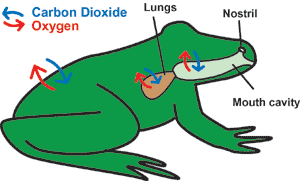Frog Respiration
Frogs have many different ways of breathing depending on which stage of life and the environment in which they reside. They unlike most animals, frogs are positive pressure breathers when they use their lungs for respiration. Unlike other animals, the frog begins its life with gills which eventually disappear once the frog has adapted to life on land. The frog is one of the only animals with multiple respiratory adaptations.
Life Stages and Breathing Processes
Once a tadpole has hatched from the egg, it begins breathing through internal and external gills which filter oxygen from the water. The oxygen is extracted by the small external gill flaps. The tadpole swims with its mouth open, taking in water which is transferred to the gills as the mouth is closing. Thin membranes, called lamellae, assist in diffusion of the extracted oxygen into the bloodstream. Tadpoles also have the skill to gulp oxygen from the air when they reach the surface.

Gills
Lungs
When the tadpole has evolved into an adult frog the gills are lost and the frog begins breathing in many different ways. Frogs use their lungs just the same as most other animals, except a frog's lungs are highly underdeveloped. Frogs lack a diaphragm, a muscle used in other species to create a pressure gradient to draw air into the lungs. So unlike other animals, the frog is a positive pressure breather. Frogs must actively pull air into their lungs by using muscles for locomotion to ventilate air into the lungs. Muscles pull air into the nares and mouth, where throat muscles are activated and push air out of the mouth and into the lungs. This process (shown right) can be seen with the human eye.


Cutaneous Breathing
Aside from breathing through their lungs, adult frogs have the ability to breath cutaneously through their skin. Over 50% of the frogs respiration occurs cutaneously. Frogs need to constantly have moist skin, this is accomplished through the use of mucus secreting glands. The moisture allows oxygen to be absorbed through the frog's thin skin which oppositely allows carbon dioxide to leave the frogs body. The oxygen enters the bloodstream through blood vessels and capillaries close to the surface, allowing the frog to be under water, mud, or other moist environments for long periods of time. This same form of respiration is used during hibernation and winter months.
Buccopharyngeal Respiration
Buccopharyngeal respiration occur through a thin membrane (the buccopharyngeal membrane) in the frogs mouth. This type of respiration only can occur when the frog's mouth is open and submerged in water. The gas exchange occurs across the thin, vascular membrane, allowing blood vessels and capillaries to transport oxygen to the blood.


